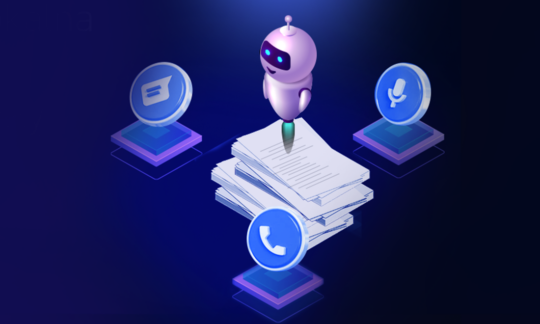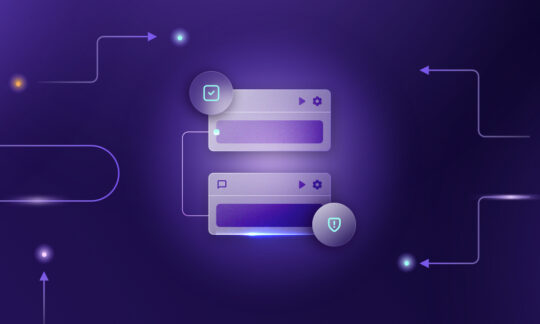The Voicebot Implementation Guide – Part 1
Over the last couple of months we devoted a lot of articles to chatbots – it’s easy to forget, however, that chatbots aren’t just useful for text communication. Voicebots, chatbots operating primarily on voice channels, are an equally important element of a modern customer service automation strategy.
We tend to associate voicebots with a robotic, fake voice and constant waiting for a list of commands we can choose from. This imagining couldn’t be farther from the truth! Modern voicebots closely resemble the AI assistants we have come to rely on in our daily lives. They are able to dynamically interpret your statements and adapt to new situations on the fly.
The bottom line is thus: voicebots shouldn’t escape your attention. According to Gartner, 25% of all customer service operations will be handled by virtual assistants this year – isn’t it time you joined the revolution yourself?
In this article we’ll describe the most important aspects of voicebots and their many applications. In the next part, we’ll focus on implementing a voicebot from scratch.
What are voicebots?
Like their name suggests, voicebots are, well, voice counterparts to chatbots. They’re computer software using a voice interface to communicate with a user. The term is broadly applied to virtual assistants (such as Amazon’s Alexa or Apple’s Siri), as well as telephone bots that handle incoming and outgoing calls. The most significant – and obvious – difference between voicebots and chatbots is the use of sophisticated speech recognition and voice synthesis algorithms.
On a technical level, aside from the added speech recognition and synthesis stage, voicebots work on the same exact principle as chatbots. They simply require slightly more processing power – after all, text analysis is much simpler than handling natural speech.
Just like chatbots, we can single out many different types and applications for the technology. We can encounter simple chatbots designed to handle simple queries, as well as advanced solutions with a wide variety of possibilities. You don’t even have to look far for an example – what is Siri if not an incredibly sophisticated voicebot?
What can voicebots do for you?
This question can be answered simply by saying “whatever you want”. We know, however, that our readers wouldn’t be satisfied with such a lowbrow answer – here, then, are all the details. Voicebots – like chatbots – can be implemented to handle basically any type of query.
They do, however, shine brightest when they are set to work on a particular type of problem. That type, then, is handling repetitive queries bogging down your customer service department. You know the ones: questions about delivery status, payment dates, product inquiries – the list is endless. Modern voicebots can also detect the customer’s intent – as such, they’re perfect for collecting leads. If your bot discovers a client’s interest in a product or service, it can easily ask for contact information that will be seamlessly plugged into your lead database or CRM application.
The possibilities for voicebots are only limited by the imagination of their creation – with enough effort and algorithm training, we can put them to work on virtually any task.
When should you deploy a voicebot?
Like we said, voicebots perform best when we need to handle a lot of repetitive tasks. In our experience, these types of tasks eat up the most time – which is a limited resource in customer service. Wouldn’t it be better to ensure that our agents have enough of it to devote appropriate amounts of care to more complicated issues?
This is where voicebots can help us. They can free us from the mind-numbing prospect of resolving dozens of identical inquiries every day. As a bonus, they don’t need time off – they can provide customer service around the clock!
Example applications of voicebots
Enough vagueness – what can voicebots actually do for us? One of the most common uses for chatbots is call steering. Instead of having to sit through a tedious list of options, the customer can simply state the nature of their business – the bot will then redirect the call to the appropriate department. This particular application is currently one of the most widespread – especially in the banking industry.
Going a step further, the voicebot can take care of client authentication – ask for the account number and other information. It’s a lengthy, oft-repeated process. As such, it’s a perfect candidate for automation – why should your agents waste time asking the same questions multiple times a day, when a bot can free them up to take care of what really matters?
That isn’t to say that voicebots excel only in customer service. They are also a perfect training tool for call centre employees. Voicebots can effortlessly assume the role of a client and generate unique conversation scenarios on the fly – no two training sessions will be the same! This is an indispensable training method.
Of course, we also have to mention the infamous robocalls. Voicebots are commonly used for sales purposes – they can dial thousands of potential customers at once. This practice, however, is perceived in an overwhelmingly negative way. Many governments around the world are passing legislation to limit this use of voicebots.
What are voicebots made of?
Like we mentioned earlier, voicebots aren’t really that different from text-based chatbots. This means they consist of largely the same elements: a natural language processing algorithm, a database, the methodology employed in its design and the personality it’ll present to its users.
The methodology – beneath this term hides the answer to a simple question. How will our bot work? We can distinguish between two main types of bots: scenario- and AI-based.
Scenario-based bots, as the same suggests, operate using a strict, predetermined scenario. During the creation process, certain keywords are chosen – the bot will recognise those keywords and respond using pre-written phrases. The creators determine every possible outcome of every conversation. As a result, scenario-based solutions are inherently limited in what they can do.
On the opposite side of the spectrum are AI-based bots. Instead of using predetermined scenarios, they learn and adapt to new situations on the fly with minimal human supervision. As a result, they are much more powerful. The costs of implementing such a bot, as well as the technical expertise needed to deploy such a solution are proportionally higher.
Regardless of the methodology, voicebots employ automatic speech recognition (ASR) algorithms. Very rarely do companies have the technical resources needed to develop their own speech recognition solution – as such, off-the-shelf libraries by companies such as Amazon are used instead.
Finally, let’s talk about the bot’s personality. The way in which our voicebot will interact with our clients has a significant impact on the way our brand is perceived. It is, however, such a broad topic that we devoted a separate article to creating your bot’s personality.
How does a voicebot work in practice?
To conclude, let’s take a look at how a voicebot is deployed and what benefits they bring. SentiOne recently delivered a new voicebot to Kruk – it was immediately put to work on reducing the call centre load and serving customers after business hours. The result? 23% of incoming calls were resolved without involving the customer service team.
Below you can take a look at how the bot works in practice:
Don’t miss the next part of this series, in which we’ll show you how to implement a voicebot from scratch – step by step!



